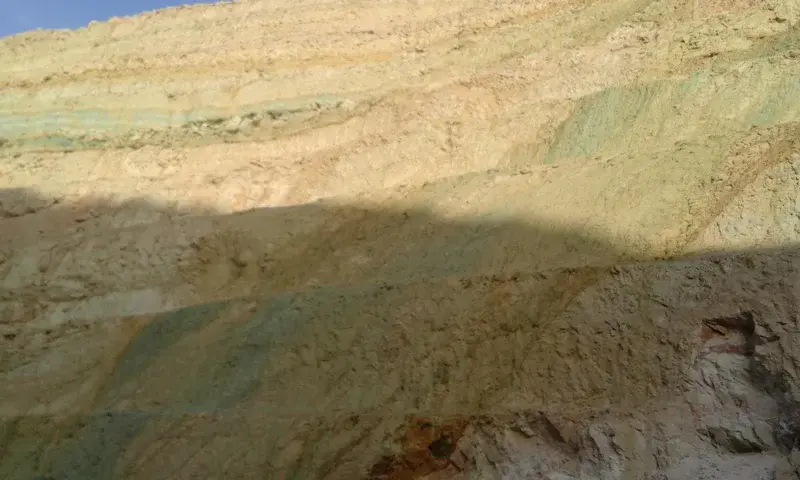
Clay Smears Exposure
by Metwally Hamza, Egyptian Geologist, Egypt
1) Abstract;
- Alnog the road of "El-Galalla", or exactly "El-Galalla New Road", there is a most one splendid and multi-awesome exposure of clay smears.
- For you; "El-Galalla Marine Plateau Road", also called "Majesty Plateau Road", is one of the most egyptian roads, that can shortage multi-distances, but the other side of it, is its most attractive and awesome exposures, such as our item.
- For you also; "El-Galalla Marine Plateau" is elevated about (700 m above red-sea-level), and this splendid exposure "Clay Smears" is limited by attached longitudes and latitudes: (32.6345 E, 28.9588 N), exactly "Ain-Sokhna - Zafarana Road", along "El-Galalla Marine Plateau", Eastern-north of Cairo, Egypt, Northern Africa, Africa. So you can go by yourself, to see it.
2) Contents;
- General vision and words about clay smears.
- Introduction to reasons and mechanisms of clay smears.
- Collected notices about clay smears, and description of general features of clay smears exposure.
- Summary of topic.
- References.
3) Generally;
- Clay Smears are a collection of fault processes and resulting fault structures that form when normal faults deform layered sedimentary sections, these elusive structures have attracted deep interest from researchers interested in subsurface fluid flow. Particularly in the oil and gas industry, and you should know that "elusive" means that is difficult to reach and be formed easley.
4) Introduction;
- Clay Smears is a blocking layer, that can seal hydrocarbons, by preventing it from scape away from its containing layers, so we can anticipate and predict that its exposure may be -not axcatly- contain hydrocarbonic oils and petroleum.
- "Clay Smears is one of the most attractive factors to petrologists, where they can anticipate that layers may contain hydrocarbons, oils, and petroleum, as this smears capture this materials by sealing process, meaningly by preventing it from scaping - Prof.\ Hamimi said".
- By this words of "Prof.\ Hamimi", we can say there are many attractive factors to petrologists to search containing oils, hydrocarbons, and petroleum layers, one of it, is Clay Smears, not depend only upon geophysical methods, but as seen this exposure -clay smears- not by aspect of accuracy, may contain hydrocarbonic oils and its extracted materials.
5) Item;
- Specialists in this type of exposures, make some predictions and anticipating, by some relations, that tie clay smears factors to some surrounding features, for example the most notable feature is normal fault, as clay smears seek side by side with it, meaningly when normal faults are formed in deformed sedimentary layers by different deformation processes, the clay smears are -exactly- formed.
- Exactly, any faults -normal faults- have sequencely not only (Throw and Distance between two opposite throws), in addition containing layers of clay smears have (Thickness), as it's layers contact with each others.
- By this factors, specialists can calculate some values of some used relations, to know the ratio of contained oils, hydrocarbons, and petroleum, to determine if it economic or not.
- "Fault seal quantitative predictions", under this outline, there are three main parts of calculations, they are sequencely:
* (Shale Smear Factors, "SSF").
* (Shale Gouge Ratio, "SGR").
* (Smear Gouge Ratio, "SGR").
- Our item is attached to the first factor (Shale Smear Factors - "SSF"), also under the outline of (Shale Smear Factors - "SSF"), there are three main relations, that are used to anticipate the ratio and percentage of contained oils, hydrocarbons, and petroleum, that are captured by this smears, this relations are sequencely:
* (Clay Smear Potential, "CSP": given by, square of thickness of source-layer divided by distance of smear).
* (Smear Factor, "SF": given by, thickness of source-layer divided by distance of smear, with variable exponents, meaningly each factor of them "Thickness and Distance" has a superscript-power, as a variable exponent).
* (Shale Smear Factor, "SSF": given by, throw of fault divided by thickness of source-layer).
6) Notable-Summary;
- Most general definition of clay smear, as conceptualized by Smith (1966), in which a fault zone, or shear zone, that contains clay derived from a faulted and offset shale layer.
- Clay Smears take the colour of yellowish green, almost.
- Clay Smears is one of the most attractive factors to petrologists, where they can anticipate that layers may contain hydrocarbons, oils, and petroleum, as this smears capture this materials by sealing process, meaningly by preventing it from scaping.
- Clay Smears are formed, by deformation processes of sedimentary layers by one of the most notable features, normal fault.
- There are many calculations, applied on clay smears containing layers, to anticipate and predict the ratios of contained oils, hydrocarbons, and petroleum, this ratios, calculated by relations of:
* (Shale Smear Factor, "SSF").
* (Shale Gouge Ratio, "SGR").
* (Smear Gouge Ratio,"SGR").
- This clay smears exposure is located along "El-Galalla New Road", between "Ain-Sokhna - El-Zafarana", Eastern-north of Cairo, Egypt, Northern Africa, Africa.
7) References:
- Weber, K. J., G. Mandl, W. F. Pilaar, F. Lehner, and R. G. Precious, (1978), "The role of faults in hydrocarbon migration and trapping in Nigerian growth fault structures", "Offshore Technology Conference 10", paper (OTC 3356), page (2643-2653).
- Peter Vrolijk, Janos Urai, and Michael Kettermann, (2015), "Clay smears, review of mechanisms and applications", "Online publication on reasearchgate.net site".
____________________
⁃ Taken and published by Geologist Metwally Hamza,
⁃ Academia: benha.academia.edu/MetwallyHamza
⁃ Let's Connect: linkedin.com/in/metwallyhamza
Categories
Location
- Africa (375)
- Northern Africa (177)
- Egypt (104)
- Exact location (32.6345 E, 28.9588 N)
Tag
Colours
Image properties
2560 × 1536 px;
image/jpeg; 1.3 MB
Taken in
2019
Submitted on 27 December 2019
Licence
Creative Commons Attribution 3.0 Unported (CC BY 3.0)
Credit
Metwally Hamza (distributed via imaggeo.egu.eu)
Share
Appreciate
Report